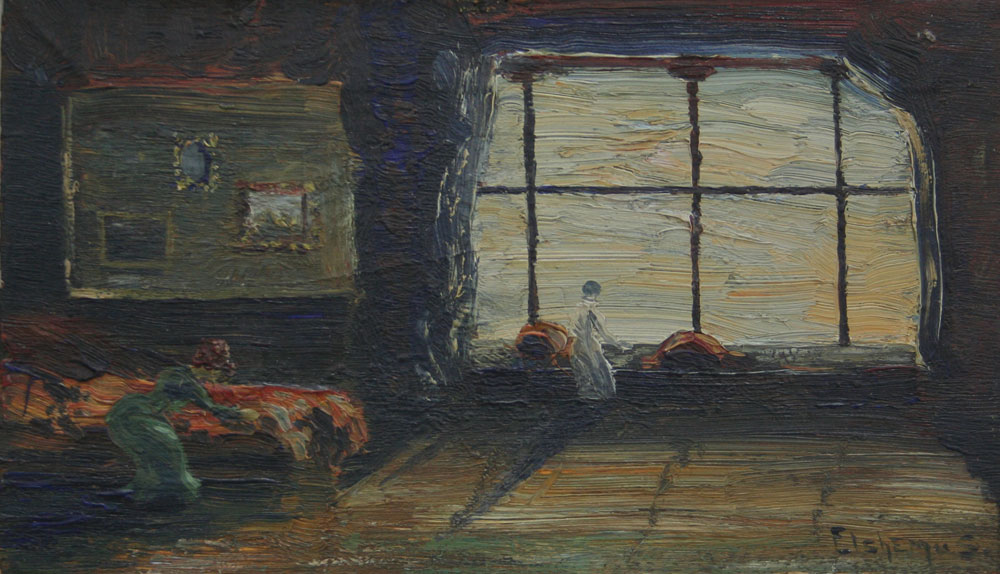E(i)lshem(i)us
42 Carlton Place, Glasgow, Scotland
42 Carlton Place, Glasgow, Scotland

Perhaps most widely known for having been ‘discovered’ by Marcel Duchamp in 1919, the American Louis Michel Eilshemius has long held the fascination of fellow artists. Stefan Banz’s recent monograph runs to an obsessive 768 pages, while painters Merlin James and Carol Rhodes, citing him as their ‘eternal contemporary’, have staged a concise exhibition of 13 of his paintings and four drawings at their project space, 42 Carlton Place, which also serves as their studio. A cursory comparison of all three oeuvres suggests a shared feeling for the balance of faintness and intensity: a sense of a glimpse; a memory; a view being brought, precariously, into focus. Eilshemius’s Volcano (c.1911) appears as the product neither of pure fantasy nor empiricism but, rather, someone imagining how an observation might look. It’s a quality shared with Henri Rousseau, with whom Eilshemius was grouped in Museum Folkwang’s recent ‘In the Shadow of the Avant-Garde’: both were ambivalent about academicism, both somehow avant-garde and vernacular, both candidates for the contested status of ‘outsider artist’. (In a 1943 review, Clement Greenberg wrote of Eilshemius’s ‘febrile, erratic intensity’ as ‘the result of a mutilation’.)

In Glasgow, Sunset (c.1910) is a cute nautical scene dumped in a bath of the ‘yellows, acid greens’ with which Greenberg identified Eilshemius’s ‘“deranged” period’. Yet there was no hint of derangement in the roughly contemporary, Interior (c.1909–13). Here, one figure busies herself at an enormous bed, while another is outlined against a vast window through which pale golden light looms. The space of the room is unreadable, its shadows picked out in a muddied ultramarine. Both bright areas and dark ones evoke something dreamy, even transcendent; as these intensities pull awkwardly against each other, however, escape is stalled. It’s an aching evocation of yearning that also feels alert to its own awful melodrama, like something in an August Strindberg play.

At still other times, Eilshemius does folksy unsophistication: the storybook green landscape of War (1917) features a stricken figure plunging from a cliff with all the physical heft and emotional gravity of a dropped gingerbread man. Indeed, it’s precisely Eilshemius’s naivety that’s widely been supposed as the ground for Duchamp’s advocacy of him: the Dadaist championing ‘bad’ work as strategic provocation. (The 1917 exhibition at which Duchamp made his ‘discovery’ was the same that had declined his Fountain.) This account has been challenged, with Banz recently arguing for the influence of Eilshemius’s several nudes by water as an influence on Duchamp’s Étant donnés (1946–66). Landscape with Figures (1919), whose central nude features the same bent leg and raised arm as the figure in Duchamp’s final work, is not on display here, though Bathers (1904) shares Étant donnés’s polished creepiness. A magazine blonde stands upfront with a rictus grin and, inexplicably, only one arm – more mannequin than human. Eilshemius’s habit of painting frames within his compositions, seen here in Volcano, among others, has also been positioned – plausibly – as a precursor to Duchamp’s use of the peephole.

Yet, if anything, the show turned my thoughts not to what came after Eilshemius but to what came just before. How, say, the exquisite, pastel-like Untitled – Exotic Scene (c.1916) looked like something Paul Cézanne, in the moment of A Modern Olympia (1874), might have turned out: both these paintings are the work of an artist looking at art history, doing something more or less uncomplicatedly libidinal, but also pulling at the elements of a picture, letting them slide apart, abase themselves and recoalesce. Like all the works in this show, it’s not without eccentricity; nor was Eilshemius himself, whom Louise Nevelson (another surprising champion) recalled giving instructions to the figures in his canvases as he painted them, and who hated being touched – another trait shared with Cézanne. In the peculiar light of Eilshemius’s scenes, eccentricity appears not as an automatic artistic handicap, but as part of the story of modernism.






















